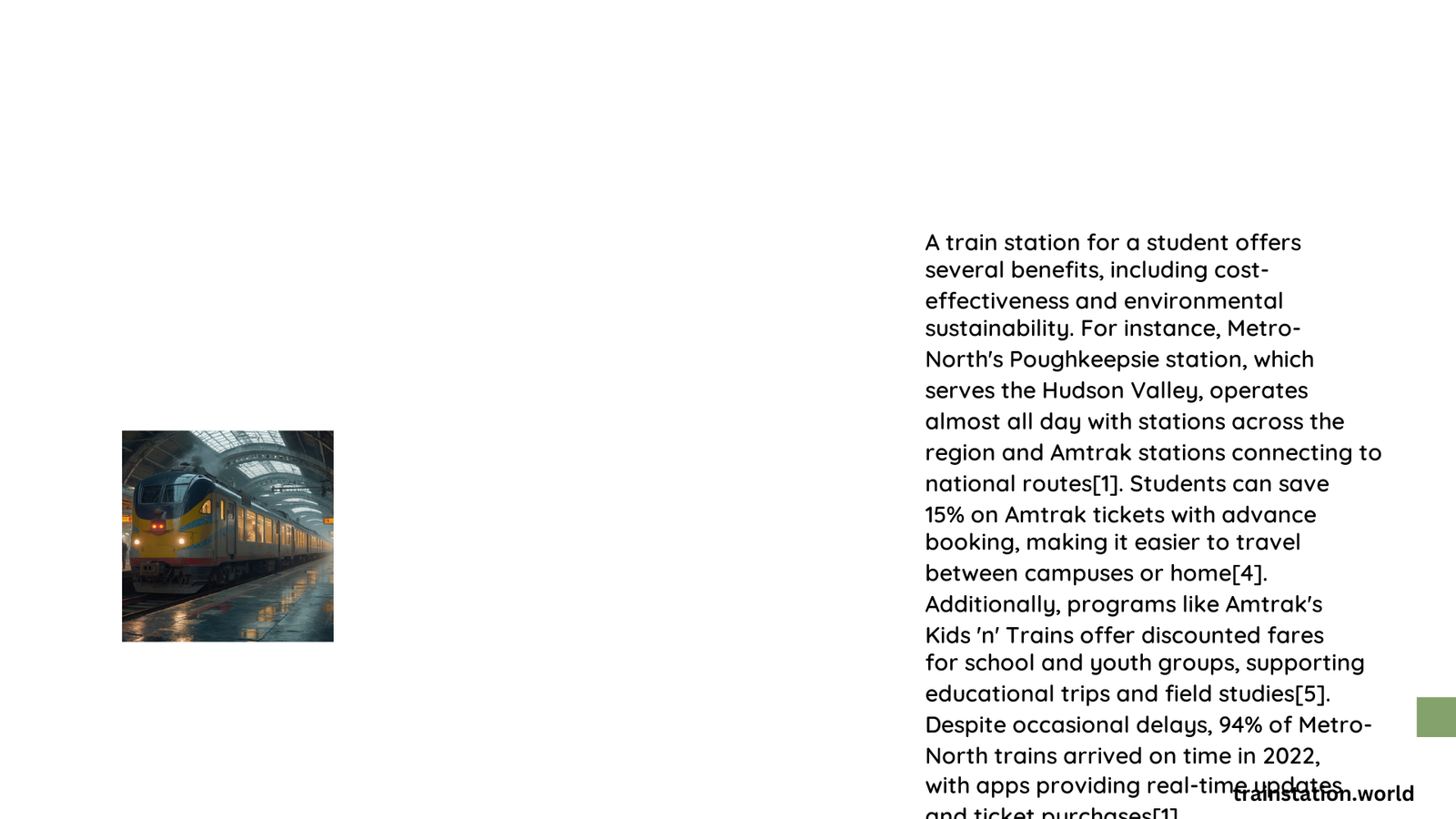Train stations serve as crucial hubs for student travelers, offering a blend of convenience, affordability, and amenities tailored to their needs. From discounted fares to study-friendly environments, these transportation centers provide unique advantages for the academic community. This comprehensive guide explores the various aspects of train stations that cater specifically to students, including facilities, safety measures, and cost-saving opportunities.
What Facilities Are Available for Students at Train Stations?
Train stations, particularly those served by major carriers like Amtrak, offer a range of facilities that cater to student needs:
- Comfortable Seating:
- Reclining seats with ample legroom
- Wider seats (23 inches) in Acela First Class
-
More legroom (42 inches) compared to airline seats
-
Power Supply:
- 120v electric outlets at each seat in Acela and Coach Class
-
Essential for keeping laptops and devices charged during travel
-
Wi-Fi Connectivity:
- Free Wi-Fi on Acela trains
-
Allows students to study, research, or complete assignments while traveling
-
Table Space:
- Available on Acela trains
- Provides a surface for laptops, books, and study materials
While dedicated study areas are not typically found within train stations themselves, the trains offer environments conducive to studying. The quiet atmosphere, especially in Acela trains, creates an ideal setting for focused work.
How Can Students Save Money at Train Stations?

Train stations and rail services offer several ways for students to save money:
- Student Discounts:
- Amtrak provides a 10% discount for students with valid ID
- Available through the Student Advantage program
-
Applicable on most Amtrak trains
-
Advance Booking:
- Booking tickets early often results in lower fares
-
Allows students to plan their travel budget more effectively
-
Off-Peak Travel:
- Traveling during non-peak hours can be more economical
-
Ideal for students with flexible schedules
-
Rail Passes:
- Some rail services offer student-specific passes for frequent travelers
- Can provide significant savings for regular commuters
What Safety Measures Are in Place at Train Stations for Students?
Train stations prioritize passenger safety through various measures:
- Lighting and Security Personnel:
- Well-lit areas throughout the station
-
Presence of security staff, especially in major stations like Boston – South Station, New York – Penn Station, and Washington – Union Station
-
Emergency Protocols:
- Access to emergency services
-
Station staff trained to handle various emergencies
-
Accessibility Features:
- Elevators, ramps, and accessible restrooms
-
Ensures safe navigation for all passengers, including those with mobility challenges
-
Surveillance Systems:
- CCTV cameras in strategic locations
- Helps monitor station activities and deter potential security threats
How Can Students Make the Most of Train Station Study Areas?
While dedicated study areas in train stations are rare, students can optimize their study time on trains:
- Noise Management:
- Use noise-canceling headphones to minimize distractions
-
Choose quieter cars when available
-
Time Management:
- Plan study sessions around train schedules
-
Use travel time efficiently for reading or reviewing notes
-
Resource Utilization:
- Take advantage of onboard Wi-Fi for research
-
Use power outlets to keep devices charged
-
Seating Strategy:
- Opt for seats with tables when possible
- Consider upgrading to business class for more space and quieter surroundings
What Additional Services Do Train Stations Offer for Student Convenience?
Train stations often provide additional services that can be particularly useful for students:
- Luggage Storage:
- Short-term storage options for heavy bags
-
Convenient for students exploring the area before or after their journey
-
Food and Beverage Options:
- Cafes and quick-service restaurants
-
Vending machines for on-the-go snacks
-
Information Desks:
- Assistance with schedules, routes, and general inquiries
-
Particularly helpful for students new to train travel
-
Mobile Apps:
- Real-time updates on train schedules
- Digital ticketing for convenience
How Do Train Stations Accommodate Students with Special Needs?
Train stations are designed to be inclusive and accommodate students with various needs:
- Accessibility Features:
- Wheelchair ramps and elevators
-
Tactile paving for visually impaired travelers
-
Assistance Services:
- Staff trained to assist passengers with disabilities
-
Pre-booking options for special assistance
-
Quiet Spaces:
-
Some stations offer quieter areas, beneficial for students with sensory sensitivities
-
Clear Signage:
- Large, easy-to-read signs and information boards
- Often includes multiple languages in diverse areas
What Environmental Initiatives Are Train Stations Implementing for Eco-Conscious Students?
Many train stations are adopting eco-friendly practices, appealing to environmentally conscious students:
- Recycling Programs:
- Clearly marked recycling bins throughout stations
-
Encourages responsible waste disposal
-
Energy-Efficient Lighting:
- LED lights and motion sensors to reduce energy consumption
-
Solar panels in some modern station designs
-
Water Conservation:
- Low-flow fixtures in restrooms
-
Water bottle refill stations to reduce plastic waste
-
Sustainable Transportation Options:
- Bike racks and storage facilities
- Electric vehicle charging stations in some locations
How Can Students Provide Feedback on Their Train Station Experience?
Train stations value student feedback to improve their services:
- Online Surveys:
- Often available through QR codes or website links
-
Opportunity to share detailed experiences
-
Social Media Channels:
- Many train stations have active social media presence
-
Quick way to provide feedback or ask questions
-
Customer Service Desks:
- In-person option to discuss concerns or suggestions
-
Immediate response to urgent issues
-
Feedback Forms:
- Available at information kiosks or online
- Can be submitted anonymously if preferred
In conclusion, train stations offer a wealth of resources and amenities tailored to student needs. From cost-saving opportunities to study-friendly environments, these transportation hubs provide an essential service to the academic community. By understanding and utilizing the various facilities and services available, students can make their train travel experiences both productive and enjoyable.
References:
1. Why Acela? | Amtrak
2. Coach Class Seat – Unreserved Services – Amtrak
